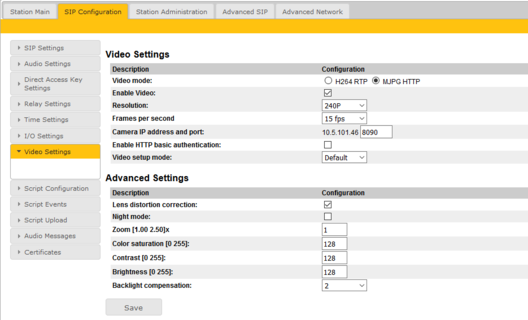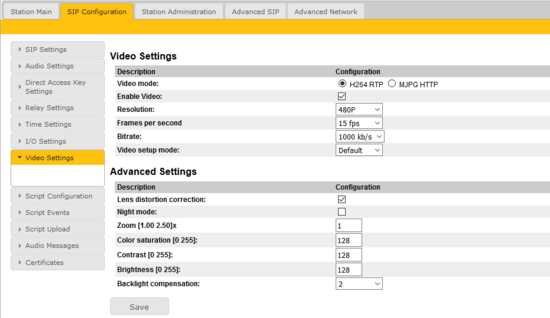Difference between revisions of "Turbine Video Settings"
From Zenitel Wiki
(→H264 mode) |
(bandwidth usage in 4.7 table updated) (Tag: Visual edit) |
||
| Line 65: | Line 65: | ||
== Bandwidth usage == | == Bandwidth usage == | ||
===H264 mode === | ===H264 mode === | ||
| − | When video is used in H.264 mode, the allocated bandwidth per stream is defined in the web interface. Available options are '''128''', '''300''', '''500''' or ''' | + | When video is used in H.264 mode, the allocated bandwidth per stream is defined in the web interface. Available options are '''128''', '''300''', '''500,''' '''1000''' or '''2500 kb/s'''. |
* Higher resolution requires more bandwidth to show a clear picture without much pixelation. More pixels require more bandwidth. | * Higher resolution requires more bandwidth to show a clear picture without much pixelation. More pixels require more bandwidth. | ||
* Higher video bandwidth setting will reduce required compression level and pixelation on movements but will require users to have higher connection or will cause massive frame loss, interruptions and latency | * Higher video bandwidth setting will reduce required compression level and pixelation on movements but will require users to have higher connection or will cause massive frame loss, interruptions and latency | ||
| Line 75: | Line 75: | ||
{| class="wikitable" | {| class="wikitable" | ||
| − | ! Resolution | + | ! Resolution |
| − | | | + | | 480P || 480P || 480P |
| + | |240P | ||
| + | |240P | ||
| + | |240P | ||
|- | |- | ||
| − | ! | + | ! FPS |
| − | | | + | | 15 || 10 || 5 |
| + | |15 | ||
| + | |10 | ||
| + | |5 | ||
|- | |- | ||
| − | ! | + | ! '''Bandwidth (mean)''' |
| − | | | + | | 1200 || 800 || 400 |
| + | |600 | ||
| + | |400 | ||
| + | |200 | ||
|- | |- | ||
| − | + | ! '''Bandwidth (peak)''' | |
| − | + | | 3000 || 2000 || 1000 | |
| − | + | |1500 | |
| − | ! '''Bandwidth ( | + | |1000 |
| − | | | + | |500 |
|} | |} | ||
| − | |||
| − | |||
| − | |||
[[Category: Turbine Configuration]] | [[Category: Turbine Configuration]] | ||
[[Category: Video]] | [[Category: Video]] | ||
Revision as of 12:24, 23 November 2018
To modify the video settings on the station models TCIV-2, TCIV-3 or TCIV-6, log on to the station web interface and select:
- Advanced AlphaCom > Video (AlphaCom mode), or
- SIP Configuration > Video Setting (SIP/Pulse mode)
What settings and options are available will depend on what firmware is used in the TCIV station.
Contents
Video Settings - Firmware version 4.7 and 4.9
This section describes the Video Settings used in firmware 4.7 and 4.9. Older versions might differ somewhat.
- Video Settings 4.7
Video settings
- Video Mode: Defines whether the video stream will be MJPG in http or H.264 in RTP.
- When the TCIV station is used in SIP or Pulse mode, you can choose to use either H.264 or MJPEG.
- When the TCIV station is used in AlphaCom mode, the station uses video mode MJPEG.
- In MJPEG the url to stream video is: http://<IP address of the camera>:8090/mjpg/video.mjpg
- Example: http://10.5.101.49:8090/mjpg/video.mjpg (The TCIV is by default using port 8090 for video. The port number is configurable, see below).
- Enable Video: This parameter defines whether calls made from the station will be video calls.
- Resolution: Sets the pixel resolution.
- Frames per second: Sets the framerate per second.
- Bitrate [H264 only]: Sets the bitrate which will be used in video stream.
- Camera IP address and port [MJPG only]: This is the IP address and port number (default is port 8090) of the camera streaming the video to a web browser or video display station. The video camera and the Turbine station have the same IP address.
- Enable HTTP basic authentication [MJPG only]: Requires username and password to fetch video when checked (default admin/alphaadmin).
- Video setup mode: Sets how the video will be established, there are two options available:
- Default - this option should be used if the station is used with AlphaCom, Pulse, or non-Cisco 3rd party SIP server
- Cisco - this option should be set if the station is used with Cisco Call Manager. This will force 25 fps framerate.
MJPG client connections limitation
If video mode is set to MJPG, the station will enforce a limit of maximum available simultaneous MJPG streams (client connections). This limit is dependent on the set resolution.
- Resolution 240P: Max. 3 simultaneous MJPEG streams
- Resolution 480P: Max. 2 simultaneous MJPEG streams
Advanced Settings (all versions)
- Lens distortion correction: Enabling this parameter will correct the “fish eye” effect that can occur on the edges of the video image.
- Night mode: Enables night mode when checked
- Zoom: This parameter sets the digital zoom of the video image. The zoom level range is 1.0 to 2.5. Once it is set higher than 1.0 it allows for offsetting the view horizontally and vertically. The offset range is -100 to 100.
- Offset Left Right: Available when zoom is set to more than 1x. Determines the width of the image.
- Offset Up-Down: Available when zoom is set to more than 1x. Determines the height of the image.
- Color saturation: This parameter sets the color saturation of the video image. The range is from 0 to 255. The default value is 128.
- Contrast: This parameter sets the contrast of the video image. The range is from 0 to 255. The default value is 128.
- Brightness: This parameter sets the brightness of the video image. The range is from 0 to 255. The default value is 128.
- Backlight compensation: This parameter sets the backlight compensation for the video image. The range is from 0 to 5. The default value is 2.
Bandwidth usage
H264 mode
When video is used in H.264 mode, the allocated bandwidth per stream is defined in the web interface. Available options are 128, 300, 500, 1000 or 2500 kb/s.
- Higher resolution requires more bandwidth to show a clear picture without much pixelation. More pixels require more bandwidth.
- Higher video bandwidth setting will reduce required compression level and pixelation on movements but will require users to have higher connection or will cause massive frame loss, interruptions and latency
MJPEG mode
In MJPG mode the bandwidth depends on the resolution, framerate, quality (compression) and the complexity of the scene. By scene complexity we mean how much activity is occurring in the scene of video that you are capturing. For instance, a person talking in front of a white wall is far less 'complex' than a crowded stadium. In general, the more color, shapes, sizes, objects and movements in a scene, the more complex that scene will be. The more complex a scene is the more bandwidth will be needed to maintain the same quality level.
The table below shows typical bandwidth usage for different settings and scene complexity:
| Resolution | 480P | 480P | 480P | 240P | 240P | 240P |
|---|---|---|---|---|---|---|
| FPS | 15 | 10 | 5 | 15 | 10 | 5 |
| Bandwidth (mean) | 1200 | 800 | 400 | 600 | 400 | 200 |
| Bandwidth (peak) | 3000 | 2000 | 1000 | 1500 | 1000 | 500 |



